It’s no surprise that a lot of animals eat grass. But what’s surprising is that grass has high cellulose content, and that’s not something every animal’s stomach can easily digest.
That’s why there’s a clear distinction between animals that do and don’t eat grass. And in this article, you’ll be introduced to some of the grass-eating animals.
Table of Contents
15 Adorable Animals That Eat Grass
Deer
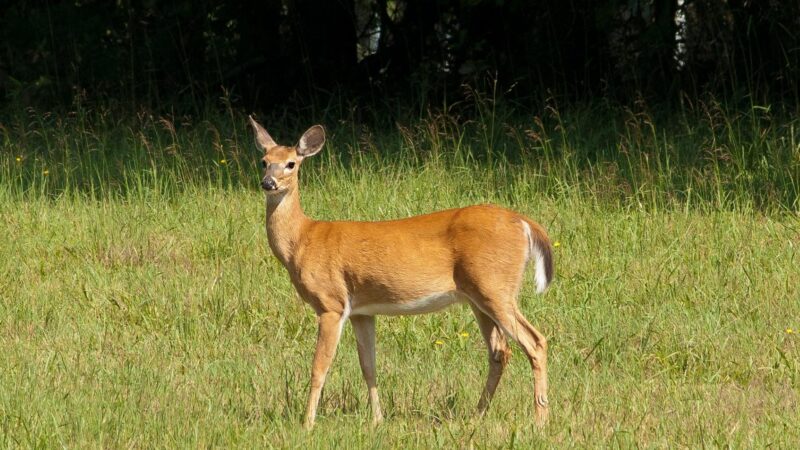
One adorable grass-consuming animal is the deer. Deers are ruminant animals or animals with compartmentalized stomachs, which helps them digest plants better than others.
Interestingly, deers are quite selective about what they eat and would often browse for food like weeds and plant shoots. They are only known to eat grass if they can’t find anything else to eat.
- Appearance: Deers are quadruped mammals noted for their reddish-brown or gray-brown fur, and stocky bodies with slender legs. Male deer are also noted for their intricate antlers that shed and grow yearly. Young fawns also have visible white spots on their backs and sides, which they lose by the time they’re 120 days old.
- Lifespan: 6 to 14 years
- Height: Up to 3 feet tall
- Weight: 80 to 160 pounds
- Place Of Origin: Eurasia
- Characteristics: Timid, non-aggressive, quadruped, nocturnal and diurnal
- Purpose: Deers are often farmed for their flavorful lean meat. On the other hand, deerskin is prized for being soft yet surprisingly resistant to abrasions.
Cows

Without question, cows are the biggest consumers of grass. Cows can eat grass at around two percent of their body weight in one day, around 20 to 30 pounds of grass.
Like deers, cows are also ruminants. But what’s special is that they have microbes inside their rumen that help break down cellulose. These microbes create a symbiotic relationship with cows in the sense that they get nutrients from breaking down cellulose, while the cows derive energy as a result.
- Appearance: Cows have rectangular and muscular bodies with elongated faces and slender legs. They have long tails with a bushy tip that’s used to swat away flies and pests. To differentiate cows from other species of the bovine family, this mammal has a more compact and low-set body. Cows come in different colors and can either be black and white, or brown or black.
- Lifespan: 15 to 20 years
- Height: Up to 4 feet and 10 inches
- Weight: Up to 1,500 pounds
- Place Of Origin: Turkey and Pakistan
- Characteristics: Diurnal, quadruped, non-aggressive, sociable
- Purpose: Depending on the breed, cows are farmed for their milk, meat, or both. In some instances, cows are also raised as pets.
Antelope
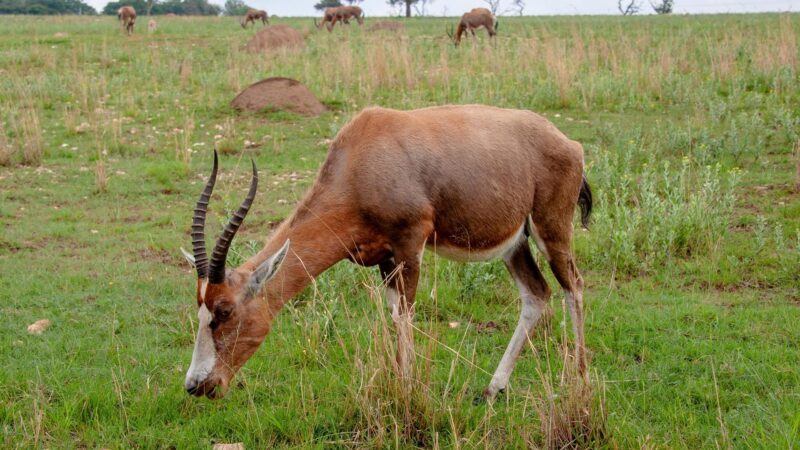
The antelope is another ruminant animal that’s known to eat grass. Antelopes are generally herbivores who survive on grass, plants, shrubs, and weeds. While antelopes have a lot of physical similarities with deers, they’re a member of the bovine family. That means that antelopes have more in common with bison and buffalos rather than deers.
- Appearance: Antelopes look a lot like large deers with v-shaped or u-shaped horns that are either straight, twisted, curved, or ridged. These animals have light brown to brown fur on the top and sides of their bodies with cream-colored fur on their underbelly. Some antelopes have black to dark brown fur lining their sides, upper hind legs, back area, and tail.
- Lifespan: 12 to 20 years
- Height: Up to 5 feet and 10 inches
- Weight: Up to 2,100 pounds
- Place Of Origin: Africa, Middle East
- Characteristics: Fast, nocturnal, crepuscular, quadruped, aggressive
- Purpose: Antelopes are raised for their tasty low-fat meat.
Zebras

Zebra’s diet mostly consists of grass. To be more specific, zebras prefer rough grass like red oat grass and Bermuda grass. With their sharp incisors and large molars, zebras have no problem cutting through and grinding the toughest grass species.
- Appearance: There’s no denying that zebras have quite an iconic appearance – with their horse-like bodies and black and white stripes all over. But unlike a horse’s long flowy mane, a zebra’s mane is short and thick. A zebra also has a black muzzle and a long tail with a bushy tip.
- Lifespan: Up to 25 years
- Height: 4 to 6 feet
- Weight: 770 to 1,000 pounds
- Place Of Origin: Africa
- Characteristics: Quadruped, social, aggressive, both diurnal and nocturnal
- Purpose: Zebras are currently considered as near threatened, and they are currently bred for conservation purposes.
Giraffe
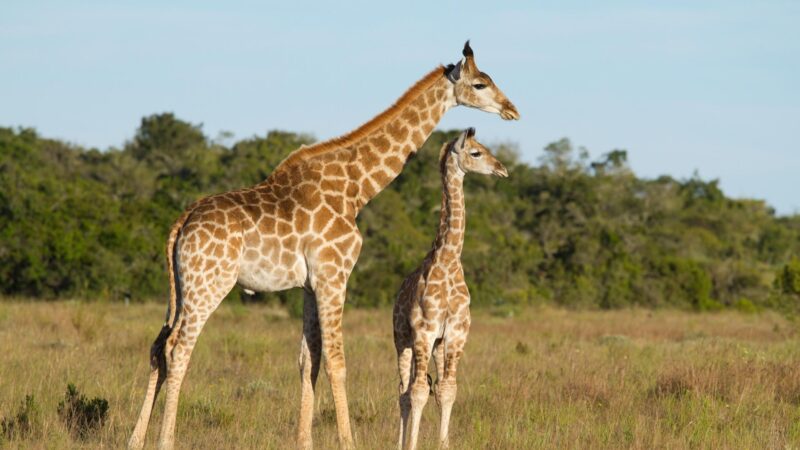
The giraffe isn’t the first animal that comes to mind when you think of grass eaters. Known as the tallest mammals on earth, giraffes often feed on leaves, buds, and fruits on trees. Nevertheless, they also eat grass when it’s available – but do not completely rely on it for a full meal.
Because of their long necks, giraffes eat grass by awkwardly splitting their legs and bowing down to reach it. They then stand up straight while chewing and would return to their grazing pose if they have to eat more.
- Appearance: Giraffes are mammals with long necks, short muscular bodies, and long legs. They have elongated faces with a pair of short horns that are covered in skin. Giraffes also have short bristle-like manes on their necks and long tufted tails. The coat pattern on the giraffe is likewise iconic. They have cream-colored fur that’s covered in patches of dark brown or reddish-brown fur all over.
- Lifespan: Up to 25 years
- Height: 14 to 18 feet
- Weight: Up to 2,600 pounds
- Place Of Origin: Eurasia
- Characteristics: Docile, non-aggressive, diurnal, social
- Purpose: Giraffes are classified under vulnerable status, with some subspecies either endangered or critically endangered. Thus, giraffes are currently bred for conservation purposes.
Giant Panda
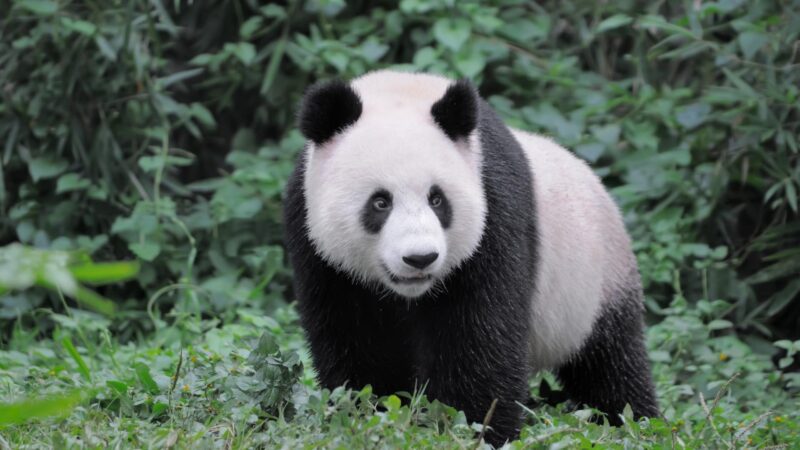
When it comes to adorable animals, there’s no doubt that the giant panda will always be on the list. Interestingly, the giant panda’s main food is bamboo, which is a type of grass. It will feast on every part of the bamboo, including its stalk, leaves, and shoots.
- Appearance: Pandas are famous for their black and white-colored fur. While their coats are predominantly white, they have black spots around the eyes, ears, legs, shoulders, and arms. Pandas also have rotund bear-like bodies, muscular legs, and tiny tails – all of which are covered in thick fur. They have round faces with a pair of small round ears sitting on top of their heads.
- Lifespan: 15 to 30 years
- Height: 4 to 6 feet
- Weight: Up to 250 pounds
- Place Of Origin: China
- Characteristics: Playful, sociable, solitary, nocturnal
- Purpose: Giant pandas are currently listed as vulnerable, which is why they are currently raised for conservation purposes.
Sheep

Another adorable ruminant that mainly consumes grass is sheep. What’s interesting about this animal is that it has no upper incisors – just a hard dental pad that helps cut down grass with its lower incisors. This unique dental feature allows them to graze as close to the roots without actually pulling them out.
- Appearance: Sheep have long, narrow faces with wide-set eyes and long ears that flop downwards. Their bodies are covered in wool, which makes them look bulkier than they are. They also have long and thin legs, which often makes them look like cotton balls with legs.
- Lifespan: 10 to 12 years
- Height: 2 to 4 feet
- Weight: 80 to 400 pounds
- Place Of Origin: Europe, Asia
- Characteristics: Meek, quiet, non-aggressive, social
- Purpose: Sheep are mainly raised for their wool, but their meat is also prized for its unique flavor. Also, some cheeses are made from sheep’s milk.
Rabbits
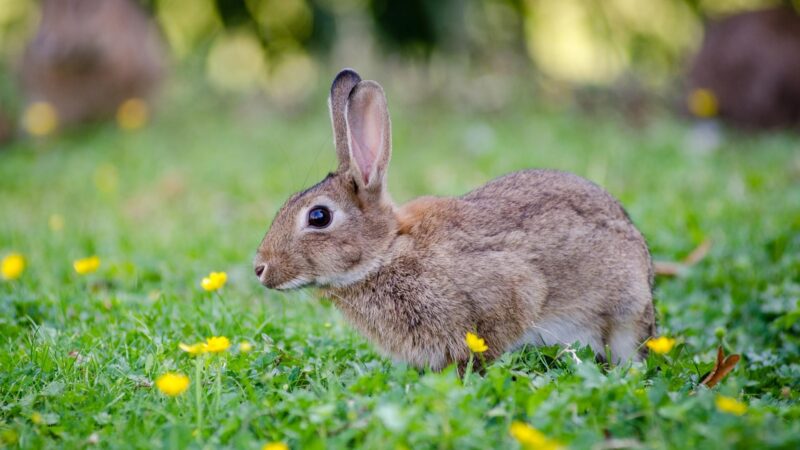
Without a doubt, rabbits are adorable. The fact that they eat grass gives them the right to be on this list. In fact, the grass is one of a rabbit’s primary food sources, apart from hay.
It’s also worth noting that rabbits are part of the lagomorph animal family. An interesting feature is that they can nibble on their food while keeping their oral cavity closed because of how flaps of skin are formed on their lips. And honestly, that makes their chewing more adorable.
- Appearance: Rabbits have small to medium-sized bodies covered in soft fluffy fur. Standout features include a pair of long slender ears and a round fluffy tail.
- Lifespan: Up to 9 years
- Height: 9 to 20 inches
- Weight: 1 to 10 pounds
- Place Of Origin: Southern Europe
- Characteristics: Playful, high-spirited, non-aggressive
- Purpose: Rabbits are considered pets and are usually raised for that purpose.
Horses

Horses have a natural high-fiber diet consisting mainly of grass and hay. They are among the grazers who can bite off the grass from the ground, thanks to its set of upper and lower incisors.
- Appearance: Being part of the equine family, horses have muscular bodies, long legs, and a tail covered in long fur. They have long faces with a pair of small pointy ears, which are connected to the body by a long muscular neck. They also have a notable mane that’s long and flowy.
- Lifespan: 25 to 30 years
- Height: 2 to 6 feet
- Weight: 800 to 2,200 pounds
- Place Of Origin: North Caucasus
- Characteristics: Social, calm, non-aggressive, quadruped
- Purpose: Horses are often domesticated and raised as pets.
Goats
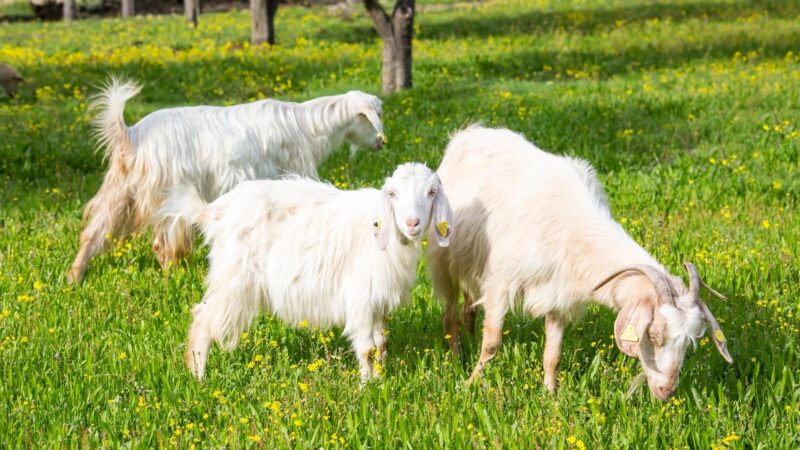
Goats are another animal that feeds on grass. Like sheep, goats do not have upper incisors, so they rely on their dental pad to help bite off the grass.
Interestingly, goats are more browsers than grazers. That means they mostly eat weeds and stalks and only eat grass from time to time.
- Appearance: Goats have compact bodies and long slender legs. They have narrow and long faces with a pair of long ears. Most goats have short horns, while others have long horns that arch backward.
- Lifespan: 15 to 18 years
- Height: Up to 3 feet
- Weight: 120 to 180 pounds
- Place Of Origin: Asia
- Characteristics: Social, dominant, aggressive, intelligent, curious
- Purpose: Goats are considered livestock, and they are mainly used for their milk and high-protein meat. Nevertheless, some goats are also raised as pets.
Capybara
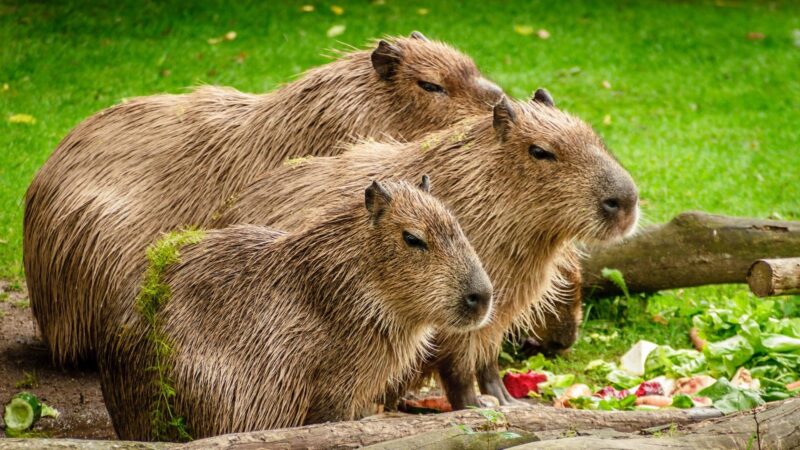
Another adorable animal that eats grass is the capybara. Dubbed the largest rodent in the world, the capybara is capable of eating up to 8 pounds of grass in a day. And that’s quite a lot, considering its size. While the capybara isn’t exactly a ruminant, its stomach contains beneficial bacteria that help break down and digest grass.
- Appearance: Capybaras have stocky bodies with no tail and four slender legs with webbed feet. They have oval-shaped heads that end with a squarish muzzle. Sitting on top of their heads is a pair of small rounded ears. Capybaras have light brown to brown bristle-like fur covering their bodies.
- Lifespan: 8 to 10 years
- Height: 3 to 4 feet
- Weight: 60 to 74 pounds
- Place Of Origin: South America
- Characteristics: Friendly, crepuscular, quadruped, social
- Purpose: Capybaras are often raised for tourism purposes, while others are raised as pets.
Grasshoppers
It comes as no surprise that grasshoppers eat grass. What’s interesting is that these tiny insects can eat up to 50 percent of their body weight in a day. But aside from grass, grasshoppers also feast on leaves, weeds, and flowers.
- Appearance: Grasshoppers are small insects with big eyes, a long pair of antennae, a pair of wings, and six limbs. It has an iconic pair of long hindlegs that helps it jump far and high – hence the name. Grasshoppers have green or brown-colored bodies to help them camouflage.
- Lifespan: 12 months
- Height: Half an inch to 2.75 inches
- Weight: 0.01 ounce
- Place Of Origin: South America
- Characteristics: Solitary, non-aggressive
- Purpose: Grasshoppers play a role in plant decomposition and as a food source for their predators. They are necessary to maintain balanced ecosystems.
Elephants
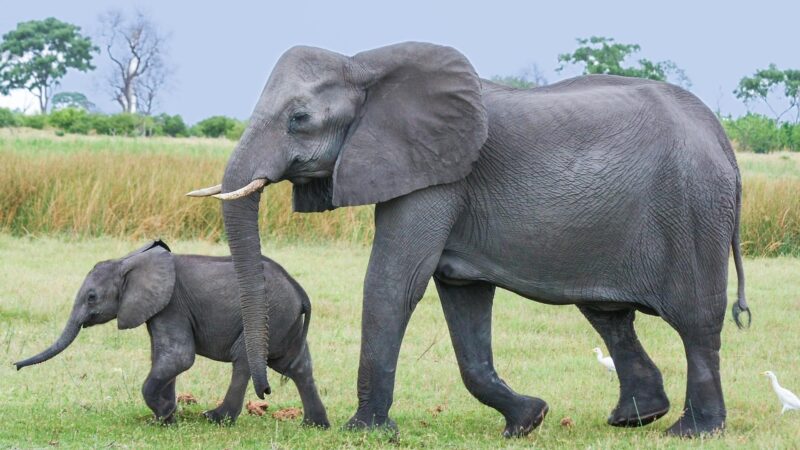
These gentle giants prefer savanna grass, but they also eat other plants, shrubs, and fruits. Elephants eat grass by pulling them out with their trunks and swinging them to their mouths.
- Appearance: Elephants are large mammals with bulky bodies, large flat ears, and long trunks. They also have notable columnar feet and a long bushy-tipped tail. Most elephants have ivory tusks – which are a pair of protruding teeth. But in Asian elephant species, only the males have tusks.
- Lifespan: 48 to 70 years
- Height: 8.2 to 14 feet
- Weight: 5,000 to 14,000 pounds
- Place Of Origin: Africa, Asia
- Characteristics: Intelligent, social, diurnal
- Purpose: Elephants are considered endangered, so they are primarily raised for conservation purposes.
Bison
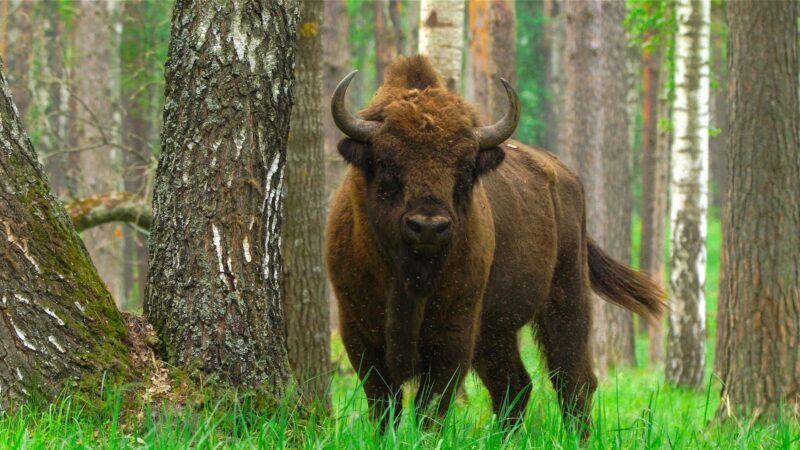
The bison is part of the bovine family and is among the biggest consumers of grass. As foragers, bison are known to eat a variety of grasses, leafy plants, and weeds that it comes across. Interestingly, the hump on a bison’s back allows it to continue foraging even during the winter months since it helps support the head as it shovels snow away.
- Appearance: This large mammal has a stocky, muscular body with a noticeable hump on its back. It has an elongated head with a pair of small horns that curves upward. The bison’s body is covered in thick shaggy fur that’s dark brown or gray-brown.
- Lifespan: Up to 20 years
- Height: 4 to 6 feet
- Weight: 1,000 to 2,000 pounds
- Place Of Origin: North America, Europe
- Characteristics: Diurnal, poor eyesight, social, aggressive
- Purpose: Bison is raised for their meat, which is considered as flavorful as beef but with less fat and cholesterol.
Wildebeest
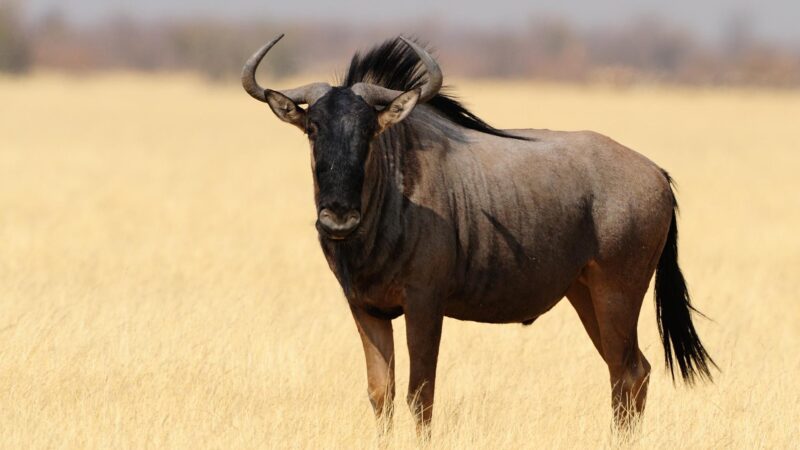
Completing this list of adorable animals that eat grass is the wildebeest. A wildebeest’s diet consists mostly of grass, but they also need a lot of water to survive. That’s why you can find herds of wildebeests eating grass that grows near a water source.
- Appearance: A wildebeest is easy to identify, thanks to their big, rectangular heads with horns that curve upwards. Their muscular bodies are covered in thin fur with a base color of brown to light brown, with black stripes from their necks to behind their shoulders. They also have a long flowy black mane and four slender legs.
- Lifespan: Up to 20 years
- Height: 4 to 5 feet
- Weight: Up to 600 pounds
- Place Of Origin: Eastern Africa, Southern Africa
- Characteristics: Solitary, territorial
- Purpose: Wildebeests are considered a big game animal, and are usually hunted for their tender and flavorful meat.
Frequently Asked Questions
Which Animal Eats Most Grass?
Cows and other ruminant animals like sheep, goats, and bison are known to eat a lot of grass. These animals have more than one stomach, and that allows them to digest grass and break down its nutrients. Also, cows can eat up to 2% of their body weight in a day – which roughly means they can consume around 25 to 30 pounds of grass in a day.
Can Animals Eat Lawn Grass?
Animals can eat lawn grass. However, some lawn grass is sprayed with pesticides, so make sure that these animals won’t eat too much of it.
How Do Grass-Eating Animals Get the Grass?
Grass-eating animals get grass through grazing. This is a feeding strategy particular to these animals that allows them to cut and eat grass without pulling out the roots.
However, different animals have different grazing strategies – like cows using their tongues to group up grass before cutting them with their dental pad or goats splitting their lips to make way for their lower teeth to bite down grass.
What Are Grass-Consuming Animals Called?
A grass-consuming animal is called a graminivore. A graminivore is a subclassification of an herbivore that has a developed stomach that can easily process the hard-to-digest components in the grass.
How Do Cows Get Nutrients From Eating Grass?
Cows get nutrients from grass through a process called rumination. This process consists of a cycle where the food enters the cow’s first stomach, then returned to the mouth for rechewing, re-salivating, and re-swallowing. This process allows the grass particles to be properly broken down and digested so that the nutrients can be properly absorbed by the cow’s body.
What Are the Nutrients Grass-Eating Animals Get From Grass?
Grass-eating animals get nutrients like carbohydrates, protein, fiber, and amino acids from grass. Vitamins and minerals like vitamin A, calcium, and iron are also present.
Summary
While grass isn’t considered food for humans, it’s the primary diet for certain animals. Ruminants like deer, cows, antelopes, goats, sheep, bison, wildebeests, and giraffes are among the primary consumers of grass.
Other adorable animals that eat grass include giant pandas, rabbits, zebras, horses, capybaras, and elephants. Even the tiny grasshopper feasts on grass. Fortunately, grass contains fiber, carbohydrates, and other nutrients, which these animals will surely benefit from.
List of Sources
Selk, G. (2016). How Much Hay Will a Cow Consume in a Day? University of Florida Extension.
Orr, A. I. (2022). How Cows Eat Grass. U.S. Food & Drug Administration.
Mason, K. (2021). Cattle Nutrition: Back to the Basics: Why do cows eat grass? University of Tennessee Institute of Agriculture. A
Parish, J. A., et al. Understanding the Ruminant Animal Digestive System. Mississippi State University Extension.
Underwood, W. J., et al. (2015). Biology and Diseases of Ruminants (Sheep, Goats, and Cattle). Elsevier Public Health Emergency Collection.